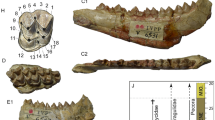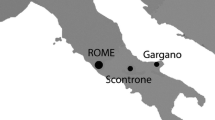Abstract
The dynamics of biodiversity of ruminants and changes in their adaptations in the Late Miocene of Austria are analyzed in connection with changes in environment and climate. At the end of the Middle Miocene through the beginning of the Late Miocene, the major reorganization of ruminant associations was recorded at the Vallesian-Turolian transition (about 8.7 Ma).
Similar content being viewed by others
References
J. Agusti and L. Cabrera, M. Carcés, et al., “A Calibrated Mammal Scale for the Neogene of Western Europe: State of the Art,” Earth Sci. Rev. 52, 247–260 (2001).
F. Bachmayer and von H. Zapfe, “Die Fauna der altpliozänene Höhlen und Spaltenfüllungen bei Kohfidisch, Burgenland (Österreich),” Ann. Naturhist. Mus. Wien 73, 123–139 (1969).
R. L. Bernor, J. Kovar-Eder, D. Lipscomb, et al., “Systematic, Stratigraphic, and Paleoenvironmental Contexts of First-Appearing Hipparion in the Vienna Basin, Austria,” J. Vertebr. Paleontol. 8(4), 427–452 (1988).
R. L. Bernor, J. Kovar-Eder, J.-P. Suc, and H. Tobien, “A Contribution to the Evolutionary History of European Late Miocene Age Hipparionines (Mammalia: Equidae),” Paleobiol. Contin. 27, 291–309 (1990).
R. L. Bernor, H.-W. Mittmann, and F. Rögl, “Systematics and Chronology of the Götzendorf “Hipparion” (Late Miocene, Pannonian F, Vienna Basin),” Ann. Naturhist. Mus. Wien, A 95, 101–120 (1993).
L. Bonis, de, G. Bouvrain, D. Geraads, and G. Koufos, “Diversity and Paleoecology of Greek Late Miocene Mammalian Faunas,” Palaeogeogr. Palaeoclimatol. Palaeoecol. 91, 99–121 (1992a).
L. Bonis, de, G. Bouvrain, D. Geraads, and G. Koufos, “Multivariate Study of Late Cenozoic Mammalian Faunal Compositions and Paleoecology,” Paleontol. Evol. 24–25, 93–101 (1992b).
L. Bonis and G. D. Koufos, “The Miocene Large Mammal Succession in Greece,” in The Evolution of Neogene Terrestrial Ecosystems in Europe (Cambridge Univ. Press, Cambridge, 1999), pp. 205–237.
de H. Bruijn, R. Daams, G. Daxner-Höck, et al., “Report of the RCMNS Working Group on Fossil Mammals, Reisenburg 1990,” Newslet. Stratigr. 26(2–3), 65–118 (1992).
S. C. Cande and D. V. Kent, “Revised Calibration of the Geomagnetic Polarity Timescale for the Late Cretaceous and Cenozoic,” J. Geophys. Res. 100(B4), 6093–6095 (1995).
G. Daxner-Höck, “Faunenewandel im Obermiozäan und Korrelation der MN-“Zonen” mit den Biozonen des Pannons der Zentralen Paratethys,” Beitr. Paläontol. 21, 1–9 (1996).
G. Daxner-Höck, “Early and Late Miocene Correlation (Central Paratethys),” Berichte Inst. Geol. Palaontol. Karl-Franzens-Univ. Graz., No. 4, 28–33 (2001).
G. Daxner-Höck, “Palaeoenvironmental History of the Vallesian and Early Turolian Reflected by Vertebrate Assemblages in the Vienna and Pannonian Basins,” in EEDEN—Environments and Ecosystem Dynamics of the Eurasian Neogene: Birth of the New World: Stará Lesná, Slovakia, November 12–16 (Univ. Komenskeho, Bratislava, 2003), pp. 38–39.
G. Daxner-Höck, “Flying Squirrel (Pteromyinae, Mammalia) from the Upper Miocene of Austria,”, Ann. Naturhist. Mus. Wien, A 106, 387–423 (2004).
E. L. Dmitrieva, Antelopes from the Neogene of Mongolia (Nauka, Moscow, 1977) [in Russian].
P. I. Dorofeev, “On the Flora of the Hipparion Epoch,” Paleontol. Zh., No. 1, 124–134 (1966).
M. Fortelius, J. Eronen, L. P. Liu, et al., “Continental-Scale Hypsodonty Patterns, Climatic Paleobiogeography and Dispersal of Eurasian Neogene Large Mammal Herbivores,” Deinsea 10, 1–11 (2003).
J. L. Franzen and G. Storch, “Late Miocene Mammals from Central Europe,” in The Evolution of Neogene Terrestrial Ecosystems in Europe (Cambridge Univ. Press, Cambridge, 1999), pp. 164–190.
L. K. Gabunia, “On the Rearrangement of the Mammal Fauna at the Boundary of the Middle and Late Miocene,” Tr. Zool. Inst. Akad. Nauk SSSR 130, 88–94 (1985).
L. K. Gabunia, “Land Mammals,” in Neogene System (Nedra, Moscow, 1986), Vol. 2 [in Russian].
L. Gabunia and K. I. Chochieva, “Co-evolution of the Hipparion Fauna and Vegetation in the Paratethys Region,” Evol. Theory 6, 1–13 (1982).
A. W. Gentry, “Ruminantia (Artiodactyla),” in Geology and Paleontology of the Miocene Sinap Formation, Turkey (Columbia Univ. Press, New York, 2003), pp. 332–379.
A. W. Gentry, G. E. Rössner, and E. P. J. Heizmann, “Suborder Ruminantia,” in The Miocene Land Mammals of Europe (Dr. Friedrich Pfeil, München, 1999), pp. 225–258.
H.-J. Gregor, Die jungtertiaeren Floren Suddeutschlands (Enke, Stuttgart, 1982).
M. Harzhauser, G. Daxner-Höck, and W. E. Piller, “Preliminary Consideration on Cyclic Stratigraphy in the Pannonian of The Vienna Basin,” in EEDEN—Environments and Ecosystem Dynamics of the Eurasian Neogene: Birth of the New World: Stará Lesná, Slovakia, November 12–16 (Univ. Komenskeho, Bratislava, 2003), pp. 29–30.
von M. Köhler, “Boviden des türkischen Miozäns (Känozoikum und Bräunkohlen der Türke”, Paleontol. Evol. 21, 33–246 (1987).
E. L. Korotkevich, History of the Formation of the Hipparion Fauna in Eastern Europe (Nauk. Dumka, Kiev, 1988) [in Russian].
G. D. Koufos, “Late Miocene Mammal Events and Biostratigraphy in the Eastern Mediterranean,” Deinsea 10, 343–268 (2003).
J. Kovar-Eder, “Pannonian (Upper Miocene) Vegetational Character and Climatic Inferences in the Central Paratethys Area,” Ann. Naturhist. Mus. Wien, A 88, 117–129 (1987).
J. Kovar-Eder, R. Givulescu, L. Hably, et al., “Floristic Changes in the Areas Surrounding the Paratethys during the Neogene Time,” in Cenozoic Plants and Climates of the Arctic (Springer, Berlin Heidelberg, 1994), pp. 347–369.
T. V. Krakhmal’naya, The Hipparion Fauna of the Ancient Meotian of the Northern Black Sea Region (Nauk. Dumka, Kiev, 1996) [in Russian].
W. Krijgsman, M. Garcés, C. G. Langereis, et al., “A New Chronology for the Middle to Late Miocene Continental Record in Spain,” Earth Planet. Sci. Lett. 142, 367–380 (1996).
A. N. Lungu, Hipparion Fauna from the Middle Sarmatian of Moldova (Shtiintsa, Chisinau, 1984) [in Russian].
A. N. Lungu, “Early Developmental Stages of the Hipparion Fauna in the Continental Frame of the Paratethys,” Extended Abstract of Doctoral Dissertation in Geology and Mineralogy (Geol. Inst. Akad. Nauk Gruz. SSR, Tbilisi, 1990).
P. Mein, “European Miocene Mammal Biochronology,” in The Miocene Land Mammals of Europe (Dr. Friedrich Pfeil, München, 1999), pp. 25–35.
L. A. Nevesskaya, I. A. Goncharova, L. B. Iljina, et al., “On the Neogene Stratigraphical Scale of the Eastern Paratethys,” Stratigr. Geol. Korrelyatsiya 1(2), 3–26 (2003).
M. A. Pevzner, A. N. Lungu, E. A. Vangengeim, and A. E. Basilyan, “The Position of Vallesian Localities with the Hipparion Fauna of Moldova Relative to the Magnetochronological Scale,” Izv. Akad. Nauk SSSR, Ser. Geol., No. 4, 50–59 (1987).
M. A. Pevzner and E. A. Vangengeim, “Relations between the Continental Scale of the Late Miocene of Western Europe and Stratigraphical Scales of the Mediterranean and Eastern Paratethys,” Izv. Akad. Nauk SSSR, Ser. Geol., No. 5, 69–79 (1984).
M. A. Pevzner and E. A. Vangengeim, “The Position of the Neogene Key Mammalian Localities of the USSR on the Magnetochronological Scale,” Abstracts of the 9th Congress of RCMNS (Sabadell, 1990), p. 267.
F. Rögl, “Palaeogeographic Consideration for Mediterranean and Paratethys Seaways (Oligocene to Miocene),” Ann. Naturhist. Mus. Wien, A 99, 279–310 (1998).
F. Rögl, “Oligocene and Miocene Palaeogeography and Stratigraphy of the Circum-Mediterranean Region,” in Fossil Vertebrate of Arabia (Yale Univ., 1999a), pp. 485–500.
F. Rögl, “Mediterranean and Paratethys: Facts and Hypotheses of an Oligocene to Miocene Paleogeography (Short Overview),” Geol. Garpath. 50(4), 339–349 (1999b).
F. Rögl and G. Daxner-Höck, “Late Miocene Paratethys Correlations,” in The Evolution of Western Eurasian Neogene Mammal Faunas (Wiley, New York, 1996), pp. 47–55.
G. E. Rössner and G. D. Koufos, “Regional Patterns in Miocene European Ruminantia,” in Proceedigs of the 5th International Symposium on Eastern Mediterranean Geology (Thessaloniki, 2004), Vol. 1, pp. 340–342.
N. Solounias and B. Dawson-Saunders, “Dietary Adaptations and Paleoecology of the Late Miocene Ruminants from Pikermi and Samos in Greece,” Palaeogeogr. Palaeoclimatol. Palaeoecol. 65, 149–172 (1988).
N. Solounias, J. M. Plavcan, J. Quade, and L. Witmer, “The Paleoecology of the Pikermian Biome and the Savanna Myth,” in Evolution of the Neogene Terrestrial Ecosystems in Europe (Cambridge Univ. Press, Cambridge, 1999), pp. 427–444.
F. F. Steininger, “The Continental European Miocene,” in The Miocene Land Mammals of Europe (Dr. Friedrich Pfeil, München, 1999), pp. 9–24.
E. Thenius, “Zur Kenntnis der fossilen Hirsche des Wiener Beckens,” Ann. Naturhist. Mus. Wien 56, 262–308 (1948a).
E. Thenius, “Über die Entwicklung des Hornzapfen von Miotragocerus,” Sitz. Österr. Akad. Wiss. Math.-Naturwiss. K1. I 157, 203–221 (1948b).
E. Thenius, “Die tertiären Lagomeryciden und Cerviden der Steiermark Beiträge zur Kenntnis der Säugetierrestene des Steirischen Tertiärs,” Sitz. Österr. Akad. Wiss. Math.-Naturwiss. Kl. I 159, 219–254 (1950).
E. Thenius, “Die Boviden des steirischen Tertiärs: Beitrage zur Kenntnis der Säugetierreste des steirichen Tertiärs: VII,” Sitz. Österr. Akad. Wiss. Math.-Naturwiss. Kl. I 161, 409–439 (1952).
E. Thenius, “Vösendorf—ein Lebensbild aus dem Pannon des Wiener Beckens,” Mitt. Geol. Ges. Wien 46, 1–109 (1954).
E. Thenius, “Zur Entwicklung des Knochenzapfens von Protragocerus Deperet (Bovidae, Mammalia) aus dem Miozän,” Z. Gesamtgeb. Geol. Mineral. Geophys. 5, 308–318 (1956a).
E. Thenius, “Ein Geweihrest aus dem Pannon des Burgenlandes,” Burgenland. Heimatbl. 18(4), 145–148 (1956b).
E. Thenius, Handbuch der stratigraphisches Geologie: Tertiär: Part 2. Wirbeltierfaunen (Ferdinand Enke, Stuttgart, 1959).
E. Thenius, “Die jungtertiaren Wierbeltierfaunen und Landfloren des Wiener Beckens und ihre Bedeutung für die Neogenstratigraphie,” Mitt. Geol. Ges. Wien 52, 203–209 (1960).
E. Thenius, “Die Säugetierfauna des Alt Pliozäns (Pannon und Pont) in Österreich,” Mem. BRGM 78, 253–258 (1974).
E. Thenius, “Zur Paläoklimatologie des Pannon (Jungmiozän) in Niederösterreich,” Neues Jahrb. Geol. Palaontol. Monats. 11, 692–702 (1982).
E. A. Vangengeim and M. A. Pevzner, “Correlation of Reference Localities of Miocene Mammal with Magnetochronological Scale,” Stratigr. Geol. Korrelyatsiya 1(1), 108–116 (1993).
I. Vislobokova, “New Species of Orygotherium (Palaeomerycidae, Ruminantia) from the Miocene of Eurasia,” Ann. Naturhist. Mus. Wien, A 106, 371–385 (2004).
I. Vislobokova and G. Daxner-Höck, “The Importance of Late Miocene Faunal Exchanges between Eastern Mediterranean Areas and Central Europe,” Proceedigs of the 5th International Symposium on Eastern Mediterranean Geology (Thessaloniki, 2004), Vol. 1, pp. 363–364.
H. Zapfe, “Die Säugetierfauna aus dem Unterpliozän von Gaiselberg bei Zistersdorf in Niederösterreich,” Jahrb. Geol. Bundesanst., No. 1–2, 83–97 (1948).
H. Zapfe, “Ein bemerkenswertes Cervidengeweih aus dem Pannon des Burgenlandes, Österreich,” Ann. Naturhist. Mus. Wien, A 98, 173–177 (1997).
Author information
Authors and Affiliations
Additional information
Original Russian Text © I.A. Vislobokova, 2006, published in Paleontologicheskii Zhurnal, 2006, No. 4, pp. 85–95.
Rights and permissions
About this article
Cite this article
Vislobokova, I.A. Associations of ruminants in Miocene ecosystems of Eastern Alpine Region. Paleontol. J. 40, 438–447 (2006). https://doi.org/10.1134/S0031030106040101
Issue Date:
DOI: https://doi.org/10.1134/S0031030106040101




